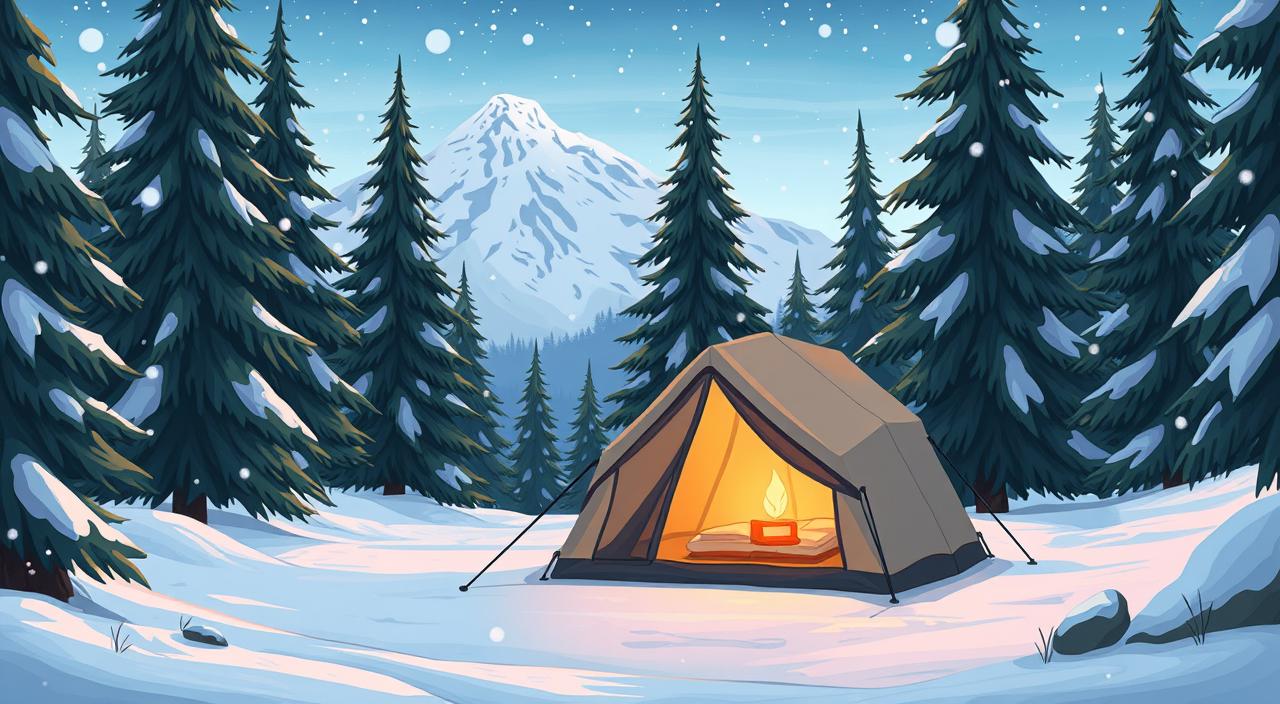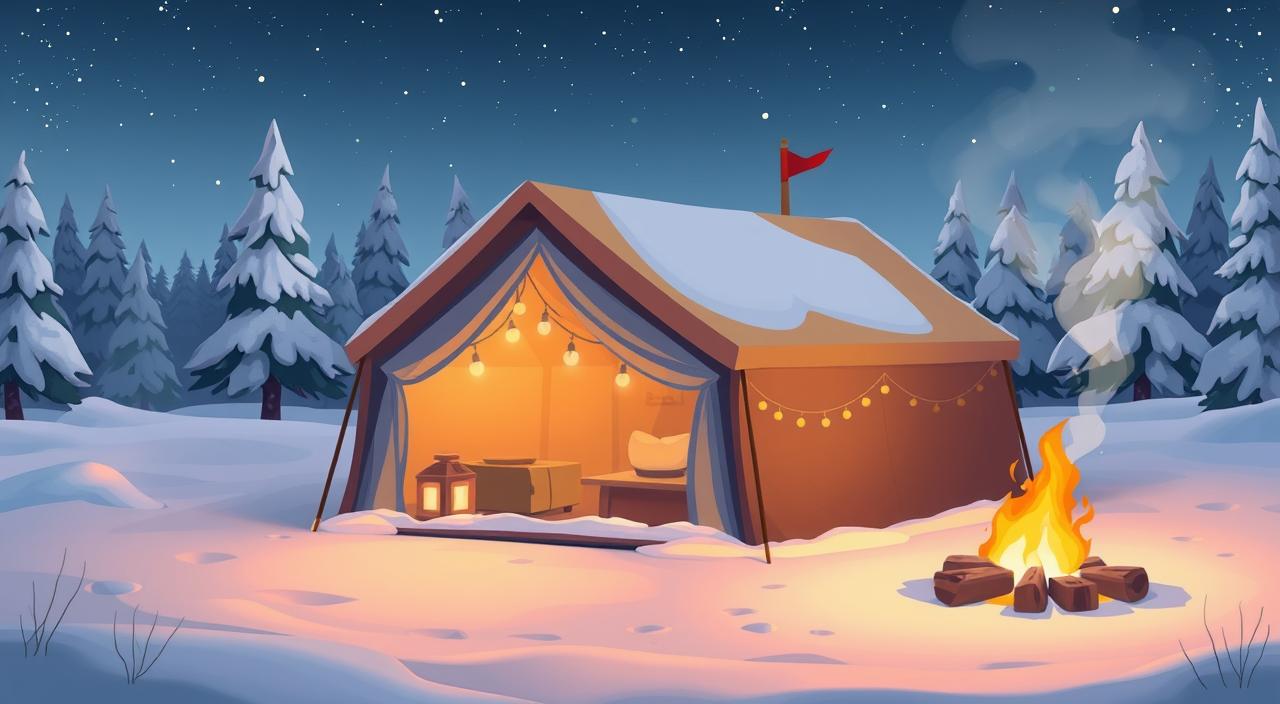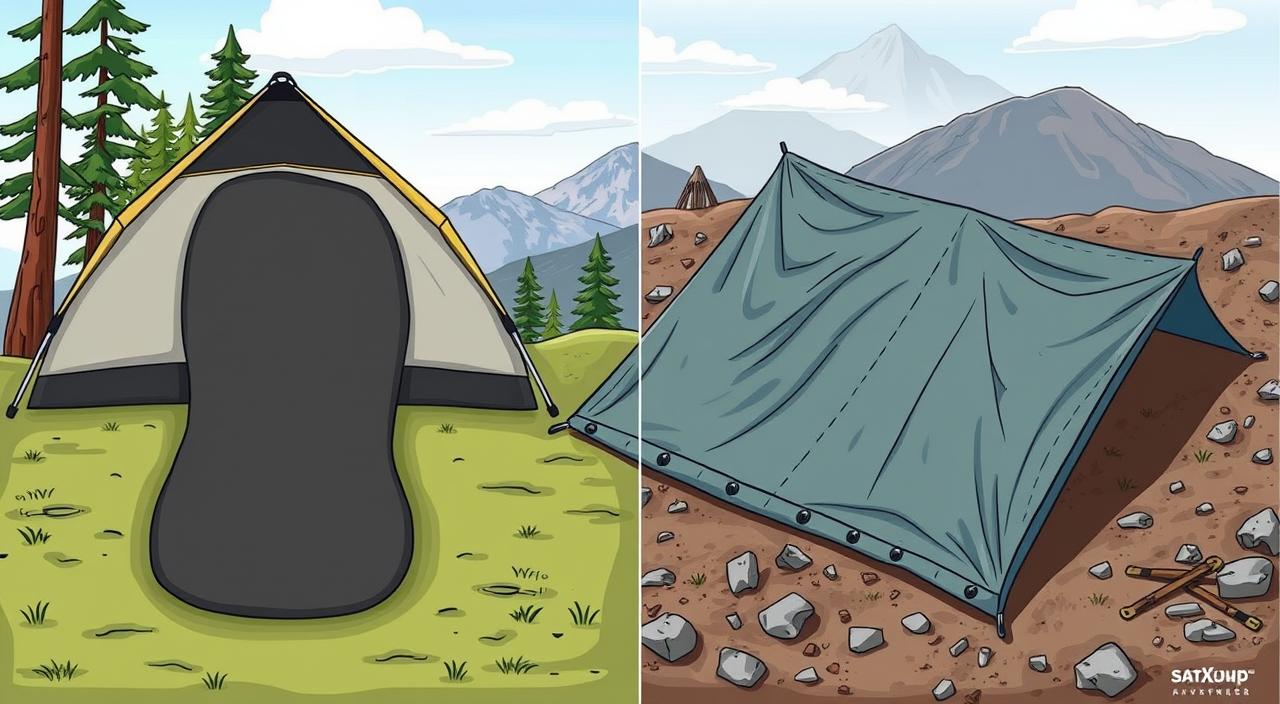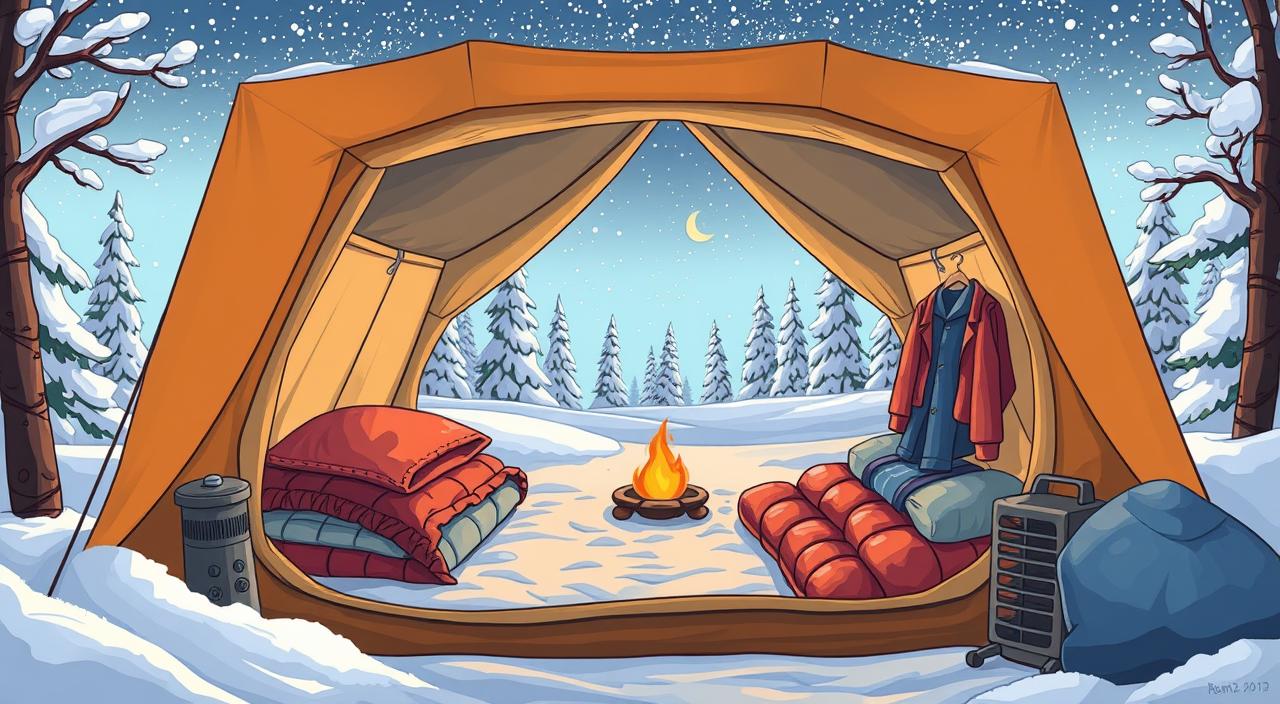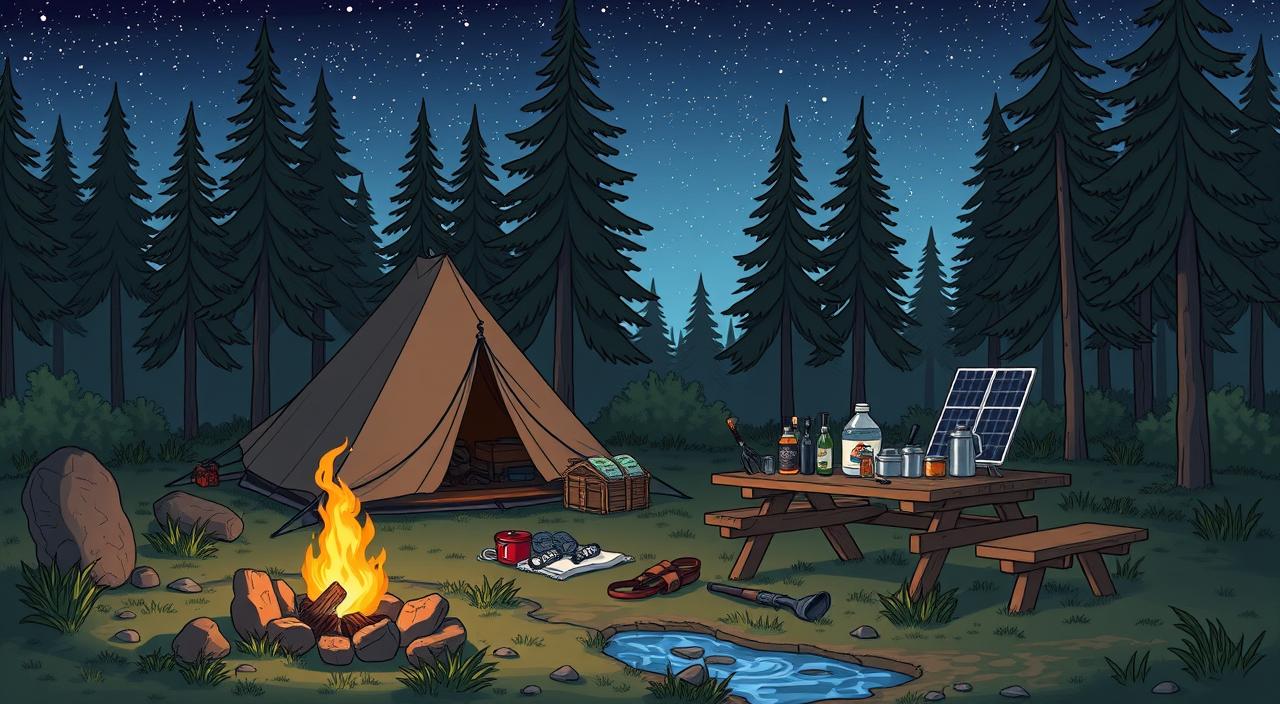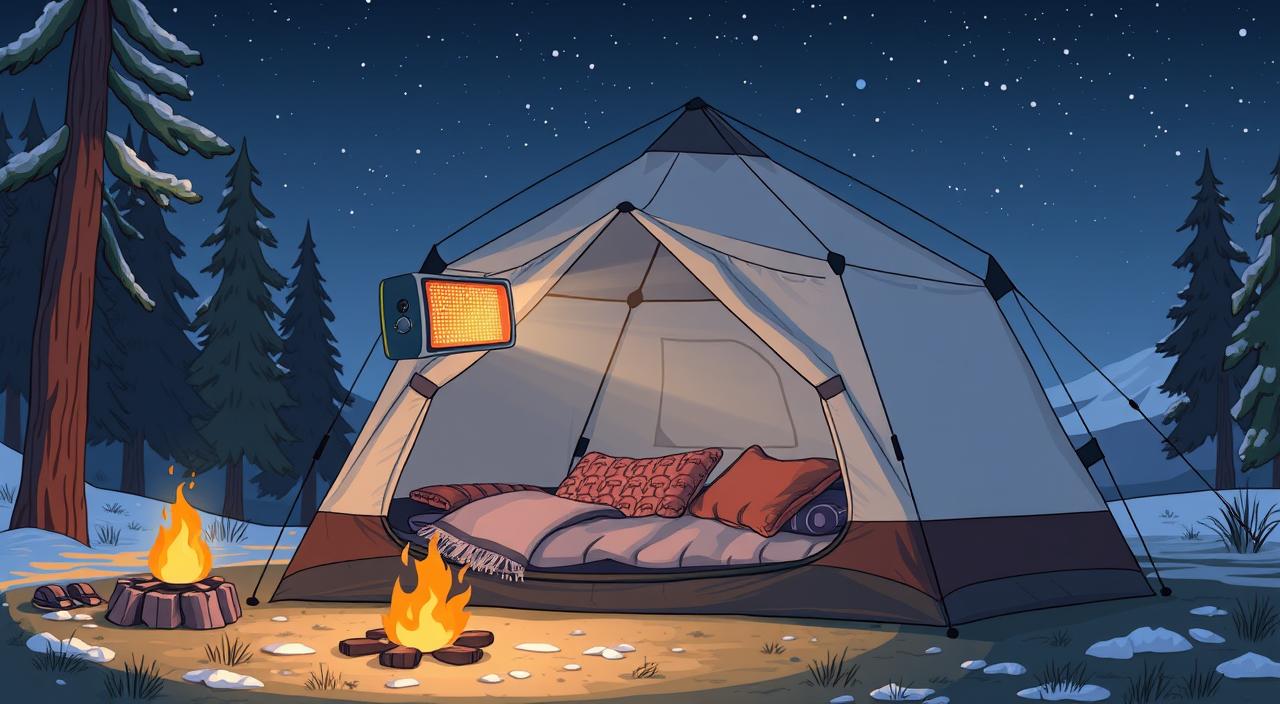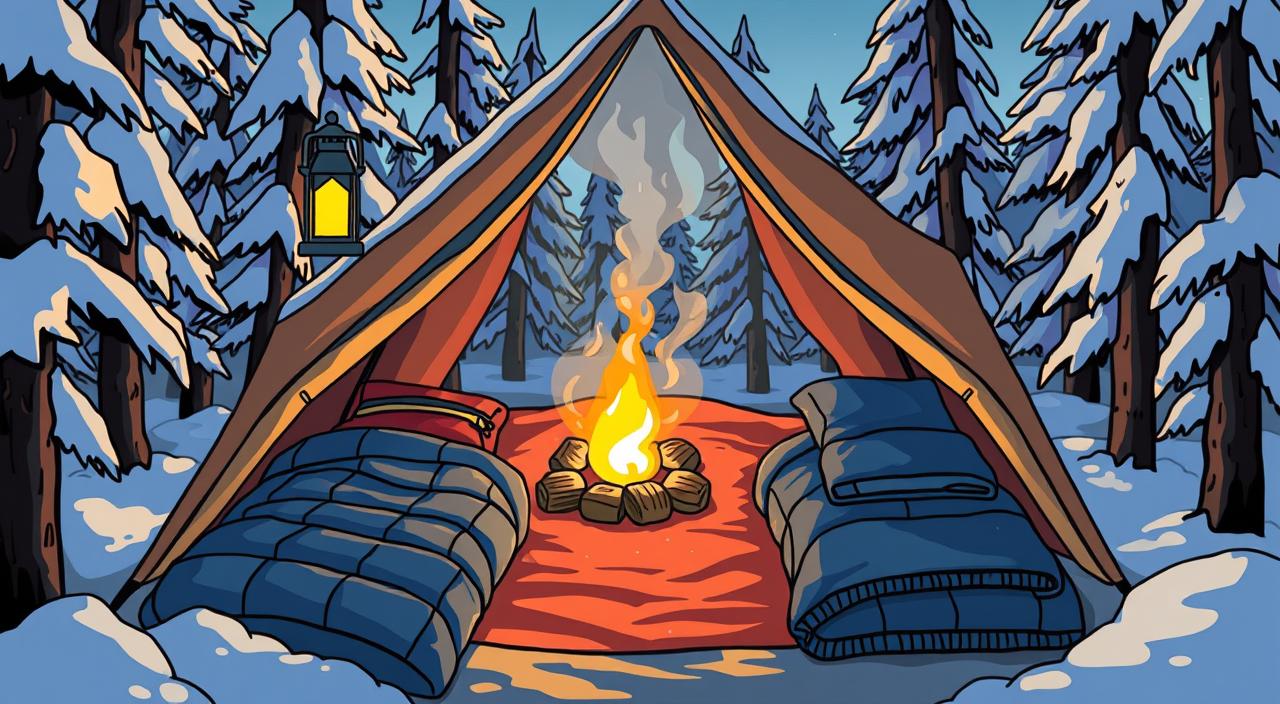
Disclaimer: This post may contain affiliate links. As an Amazon Associate, we earn from qualifying purchases.
Ever thought about enjoying winter camping without freezing in your tent? Staying warm at night is key for your health and a good camping trip. When it gets cold, many campers aren’t ready, leading to discomfort and danger. We’ll share smart tips to keep you warm in your tent, focusing on winter camping prep. We’ll cover everything from picking the right gear to tent insulation tips.
Key Takeaways
- Understanding the need for warmth is key for a great winter camping trip.
- Picking the right tent can make a big difference in your comfort in cold weather.
- Insulating your tent floor helps keep the heat in.
- High-quality sleeping bags made for the cold are a must-have.
- Using camp heaters safely can warm up your sleeping area.
- Wearing layers and heated blankets keeps you warm all night.
Understanding the Importance of Staying Warm
Staying warm while camping in winter is key to a good experience. It’s not just about feeling cozy; it’s vital for your health and safety. Cold can lead to hypothermia risk, which can get worse fast if you’re not careful.
Even in mild winter nights, temperatures can drop a lot. Without the right gear, you might struggle to keep warm. A good sleeping bag is a must. Down insulation is strong and warm but not good when wet. Synthetic bags are better for wet seasons.
For cold nights, choose sleeping pads with an R-value over 4. This keeps you warm in temperatures below 15°F.
Winter camping safety means knowing how fast you can lose heat. Wear wool socks, gloves, and beanies to keep your hands and feet warm. A tent rug or footprint also helps keep you safe by protecting you from the cold ground.
Knowing how to stay warm can stop dangerous situations. Use hot water bottles or quality sleeping gear to stay warm. Being prepared for the cold lets you enjoy your outdoor time without worrying about getting sick.
Choose the Right Tent for Winter Camping
Choosing the right tent is key for winter camping. Not all tents can handle the harsh winter weather. For winter adventures, go for 4-season tents made for such conditions. These tents have strong build, less air flow, and a shape that keeps snow off.
Check the temperature rating of the tent. A good tent should keep you warm in freezing nights. Look for tents made of weather-proof materials that can stand up to wind and snow. A smart design helps block strong winds, making you more comfortable.
How you set up your tent affects its warmth and insulation. Make sure it’s securely staked and the ground tarp is down to keep moisture out. Here are five top picks for winter camping:
| Tent Model | Capacity | Weight | Temperature Rating |
|---|---|---|---|
| Big Agnes Copper Spur 3 | 3 Person | 4 lbs 10 oz | -20°F |
| MSR Hubba Hubba 2 | 2 Person | 3 lbs 8 oz | -10°F |
| Big Agnes Crag Lake 2 | 2 Person | 4 lbs 2 oz | -15°F |
| REI Co-op Half Dome SL 3+ with Footprint | 3 Person | 5 lbs 14 oz | 0°F |
| NEMO Dagger OSMO 3P | 3 Person | 5 lbs 7 oz | 0°F |
Choosing the right tent is crucial for a great winter camping trip. A quality tent offers shelter and keeps you warm and comfy on your journey.
How to Stay Warm in a Tent: Insulating Tent Floors
Insulating your tent floor is key to staying warm when camping in the cold. Using the right materials and techniques can make your tent feel cozy. Foam pads and reflective materials are great for keeping heat in and making you more comfortable.
Using Foam Pads or Reflective Materials
Foam pads are great insulators, keeping the cold ground from reaching you. They’re comfy and have a high R-value, which means they’re good at keeping warm air in. For example, the SkyPad sleeping mat has an R-value of 4.4, perfect for winter camping.
Adding reflective materials like foil blankets can also help. They reflect your body heat back into the sleeping area, making you warmer.
Cotton vs. Synthetic Ground Covers
Choosing between cotton and synthetic ground covers is a common decision. Cotton is breathable and absorbs moisture, but it might not keep you as warm. Synthetic covers, on the other hand, are better insulators and last longer. But, they can hold onto moisture if not well-ventilated.
So, picking the right insulating materials for your tent floor can really improve your camping comfort in the cold.
Invest in Quality Sleeping Bags
For cold weather camping, getting a good sleeping bag is key. These bags are your shield against the cold, keeping you warm all night. It’s important to know how to pick the right one for your needs. The temperature ratings vary by brand, affecting how well a bag works in different weather.
A bag rated for 20°F might feel colder if it’s not well-made or if you’re sensitive to cold. So, understanding sleeping bag ratings is crucial for your comfort and safety.
Understanding Sleeping Bag Ratings
Learning about sleeping bag ratings can make your camping trips better. Each bag has a comfort rating, which tells you the lowest temperature you can sleep in comfortably. Here’s a quick guide to some common ratings:
| Sleeping Bag Type | Temperature Rating | Ideal Use |
|---|---|---|
| Teton Sports Altos -10 Ultralight Down Mummy Bag | -10°F | Extreme cold conditions |
| Feathered Friends Hummingbird UL 30 | 30°F | Cool weather |
| Mountain Hardwear Phantom 30 | 30°F | Camps in mild climates |
Knowing these ratings helps you get ready for the weather and ensures a good night’s sleep.
Choosing the Right Type for Cold Weather
Choosing the right sleeping bag style is crucial for cold weather camping. Mummy bags are great because they keep your body heat in by fitting snugly. They have draft collars and hoods to stop heat from escaping. On the other hand, rectangular bags give you more room but might let more heat out.
Adding an insulated sleeping pad, like the Big Agnus Insulated Sleeping Pad, can also help keep you warm. It acts as an extra layer of insulation against the cold ground.
Think about using a sleeping bag liner to boost your bag’s warmth. Liners can add a few degrees and make cleaning your bag easier. Dress in layers for cold nights and consider using hot water bottles for extra warmth. Camping smart keeps your adventure fun, even when it’s freezing.
Utilize Camp Heaters Effectively
When winter camping, camp heaters can make your tent warm and cozy. Coleman camp heaters are popular for their reliability and easy to carry. The Etekcity Space Heater also provides warmth but has limits on fuel types. Knowing the different heaters can help you choose the best one for your trip.
Types of Heaters: Coleman Camp Heaters vs. Etekcity Space Heaters
It’s important to pick the right camp heater for comfort. Here’s a look at Coleman and Etekcity heaters:
| Feature | Coleman Camp Heaters | Etekcity Space Heaters |
|---|---|---|
| Weight | Varies, generally lightweight | Typically lightweight |
| Fuel Source | Propane or butane | Electricity |
| Heat Output | Varies, can produce 9,000 BTUs | Variable depending on model |
| Run Time | Up to 5 hours on a propane bottle | Depends on electrical availability |
| Pros | Portable, effective for heat | No carbon monoxide |
| Cons | Carbon monoxide risk without ventilation | Requires electricity |
Safety Tips for Using Heaters in a Tent
Using camp heaters safely in a tent is key. Here are some important tips:
- Always ventilate your tent to avoid carbon monoxide buildup; gas heaters should never be used in a closed space without open vents.
- Avoid using unvented heaters inside your tent to reduce the risk of poisoning.
- Never leave heaters on when you’re not there, turn them off when you sleep or leave the tent.
- Check for gas leaks if you are using propane heaters before starting them up.
- Learn the safety rules for your heater model from the manufacturer.
Warm Your Sleeping Area with Hot Water Bottles
On cold camping nights, hot water bottles can make a big difference. They provide comfort and create a warm spot in your sleeping bag. This makes freezing temperatures feel more bearable.
To start, boil water and fill leak-proof bottles with it. Wrap them in a soft cloth to avoid burns. Put the bottles in your sleeping bag before you sleep, and you’ll stay warm for hours.
When it gets as cold as 7 degrees with a windchill, hot water bottles can be a lifesaver. They’re light and efficient, weighing about 17 ounces for a 1-liter bottle. This is much lighter than other gear you might carry.

Campers often use a standard bottle in their sleeping bag and refill it from a flask. This method keeps you warm for 4-6 hours. For even longer warmth, use a foam cozy for your bottle. It can stay warm for up to 7 hours and weighs less than an ounce.
| Item | Weight | Duration of Warmth |
|---|---|---|
| 1-Liter Flask | 17 ounces | 4-6 hours |
| Hot Water Bottle with Foam Cozy | 7 hours | |
| Chemical Hand Warmers | Approx. 2 ounces | 8 hours |
Winter camping requires smart solutions, and hot water bottles are a great choice. They’re an old-school but effective way to stay warm when it’s cold. Try them out on your next camping trip and feel the difference.
Layer Up with Thermal Underwear and Heated Blankets
When you’re camping in the cold, layering is key for staying warm and cozy. Start with high-quality thermal underwear to fight the chill. These clothes keep you insulated and dry by wicking away moisture from your skin. Merino wool and synthetic materials are great because they last long and manage moisture well.
Don’t forget about heated blankets for extra warmth while you sleep. They make a big difference when it gets cold. Look for heated blankets made for camping that use power wisely. You might layer four wool blankets and add a heated one for the best warmth.
Keep your sleeping area cozy with hot water bottles or natural fiber blankets like cotton flannel. These materials keep heat in well. On really cold nights, wear base layer pajamas, warm socks, and a knit cap or a down jacket to stay warm. Gloves and headbands help protect your hands and head from the cold.
Insulation under you is also important. A good mattress can make a big difference by keeping you off the cold ground. If it’s around 40°F or 4°C, these tips are key for a good night’s sleep. Using thermal underwear and heated blankets helps you enjoy winter camping comfortably.
For more tips on staying warm while camping, check out this helpful guide.
Simple Solutions: Hand Warmers and Foot Warmers
When camping in cold weather, keeping your hands and feet warm is key to comfort. Hand warmers and foot warmers are great for this. They are easy to carry and can be put in your gloves or sleeping bag. They give you warmth quickly and don’t take up much space.
Heated insoles are another good choice. They go inside your boots, making them warm and cozy. Choosing reusable hand and foot warmers is better for the planet and still keeps you warm. These products can stay warm for a long time, making them perfect for longer trips.
Here’s a quick comparison of different types of hand and foot warmers to help you make an informed decision:
| Type | Duration | Reusability | Best Use |
|---|---|---|---|
| Disposable Hand Warmers | Up to 12 hours | No | Quick outings, easy to pack |
| Reusable Hand Warmers | Up to 3 hours | Yes | Longer trips, sustainable |
| Heated Insoles | Up to 8 hours | Varies by brand | Cold weather hiking, all-day warmth |

Adding hand warmers and foot warmers to your camping gear can really help. These simple items keep your hands and feet warm. This lets you enjoy nature more without worrying about the cold. With the right gear, staying warm in your tent is easy, making your camping trip better.
Ventilation Tips to Reduce Condensation
Proper ventilation is key when camping in the winter. When you breathe, warm vapor leaves your body and hits the cooler tent walls. This can cause condensation. Here are some tips to help:
- Open vents and windows for better air circulation.
- Roll back the rain fly to promote airflow.
- Position your tent door facing the wind.
Choosing the right tent can also make your camping trip better. For example, the Alto and Telos tents have up to 60% more airflow. They also cut humidity levels by 31% compared to many other tents.
Where you set up your tent is also crucial. Here are some tips to lower moisture:
- Camp on higher ground to avoid cool, damp air.
- Avoid camping near water sources where ground moisture may rise.
- Set your tent in areas with shade to prevent excess heat.
Let your damp gear dry outside instead of bringing it inside. This helps keep humidity levels comfortable. Remember, each person can exhale about a liter of water at night. Good ventilation before bed can help reduce condensation.
Features like the Apex Vents and Tension Ridge in the Telos and Alto tents improve airflow. They let warm air escape at the top. If you’re sensitive to moisture, bring a microfiber towel to dry off excess moisture.
By using these ventilation tips, you can stay warmer and more comfortable while camping in the winter.
Organizing your Tent for Maximum Retention of Heat
Getting your tent organized is key to keeping warm while camping in the winter. Start by placing your gear away from where you’ll sleep. This keeps drafts out and keeps you warm. Put your sleeping bags near heat sources so everyone can stay cozy.
Here are some tips for a warm winter camping trip:
- Arrange your sleeping area centrally to spread the warmth evenly.
- Employ sleeping bag liners, which can increase warmth by up to 15°F.
- Choose insulated sleeping pads with a high R-value for better warmth.
- Consider a four-season tent for extra warmth and protection.
- Preheat your sleeping bag with a hot water bottle for extra warmth before sleeping.
Having your tent set up right makes a big difference in how comfortable you are. The right setup means you can stay warm even when it gets cold.

Conclusion
Winter camping doesn’t have to be hard. With the right tips and gear, you can stay warm and cozy in your tent. Proper insulation, quality gear, and smart strategies are key to beating the cold.
Choosing the right sleeping bags and wearing layers are important. Also, using heaters can make a big difference. And don’t forget, eating well and drinking plenty of water helps keep you warm too. A well-set tent can also be a cozy place to be.
Use these tips for your winter camping trips and make the cold nights warm and fun. Whether you’re using heated blankets or hot water bottles, you can stay comfy. Enjoy the beauty of winter while staying warm and safe!



